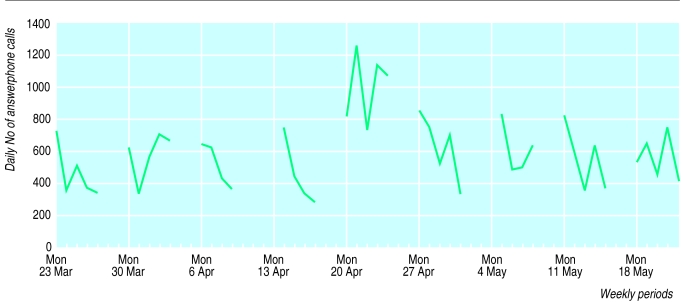Editor—It is known that a patient with cancer can be influenced in her choice of treatment by the choice made by a famous person with the same disease. When Nancy Reagan, the wife of the then American president, chose a mastectomy in 1987, there was a subsequent 25% decrease in the number of women choosing breast conserving surgery.1,2 A celebrity’s death can have a similar powerful effect. The death of Diana, Princess of Wales, resulted in unprecedented public and media response.3,4 The death of Linda McCartney in April has also shown that patients may be substantially affected by such a tragedy.
CancerBACUP’s telephone information service answered 40 715 calls (daily average 160) in April 1997 to March 1998, 11 675 of which were related to breast cancer. When all lines are busy, calls are directed to a call logging machine; on average 500 calls a day are logged. BT provides data on “ineffective” calls to the freephone—that is, those in which the caller obtains the engaged signal when all the nurses and answering machines are busy. About 5500 calls are ineffective.
In the week after Linda McCartney’s death (announced on Sunday 19 April), calls and inquiries about breast cancer increased substantially. Additional resourced lines increased the daily average number of calls to 204 (44 more calls). Seventy two calls daily (28 more calls) were about breast cancer, representing a 64% increase in the number of answered calls about breast cancer. In the same week, despite the extra open lines, the daily average number of calls logged to the answering machines doubled to 1008, the highest daily number being 1262 (figure). Altogether 1090 (14%) of the weekly calls obtained the engaged signal. As far as we can ascertain there were no factors other than Linda McCartney’s death that affected use. The next highest number of logged calls outside that week was 1106 (on 24 February), the day after the announcement that cancer had overtaken heart disease as the major cause of death. Other publicity, such as the American tamoxifen prevention trial (early April) and the role of anti-angiogenesis agents (early May), had a minor effect compared with that about Linda McCartney’s death.
The death of a celebrity from a disease, so publicly explored, presumably forced women to face their own mortality. The result was a tremendous need for information, emotional support, and reassurance. Such a response indicates, perhaps, that however well a woman copes with a diagnosis of breast cancer, anxiety is never far from the surface.
Figure.
Daily number of calls received by answerphone (that is, not answered by nurses) on each working day Monday 23 March to Friday 22 May 1998. Vertical lines represent Mondays; two Mondays were public holidays
Footnotes
mboudioni@cancerbacup.org
CancerBACUP exists to meet information needs of patients with cancer and their relatives and friends.
References
- 1.Wise J. Celebrities influence the public. BMJ. 1998;316:801. . (14 March.) [Google Scholar]
- 2.Nattinger AB, Hoffmann RG, Howell-Pelz A, Goodwin JS. Effect of Nancy Reagan’s mastectomy on choice of surgery for breast cancer by US women. JAMA. 1998;279:762–766. doi: 10.1001/jama.279.10.762. [DOI] [PubMed] [Google Scholar]
- 3.Morgan-Jones R, Smith K, Oakley P. The “Diana effect.”. BMJ. 1998;316:1750–1751. doi: 10.1136/bmj.316.7146.1750b. . (6 June.) [DOI] [PMC free article] [PubMed] [Google Scholar]
- 4.Shevlin M, Brundsen V, Walker S, Davies M, Ramkalawan T. Death of Diana, Princess of Wales. BMJ. 1997;315:1467. [PMC free article] [PubMed] [Google Scholar]



